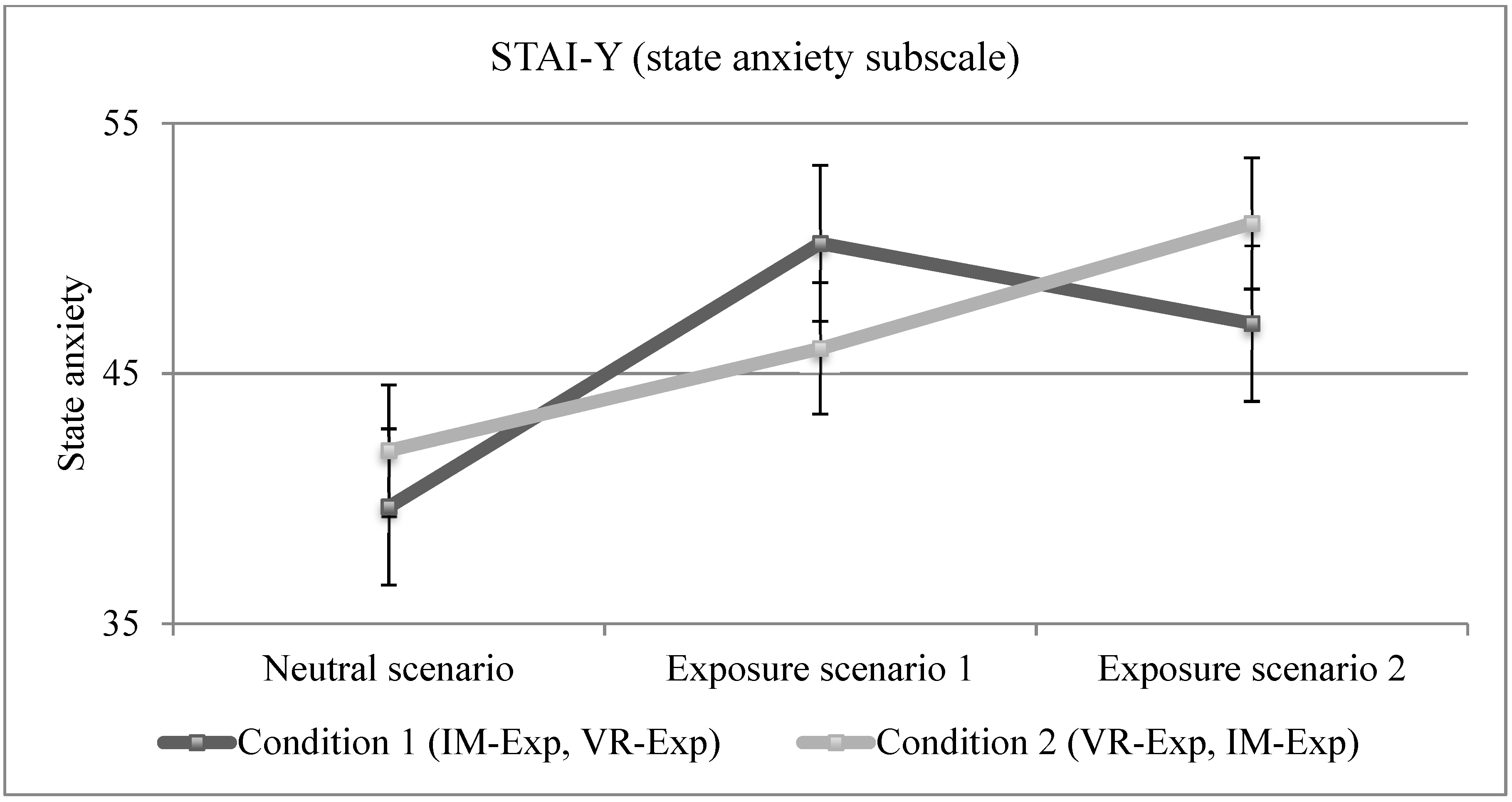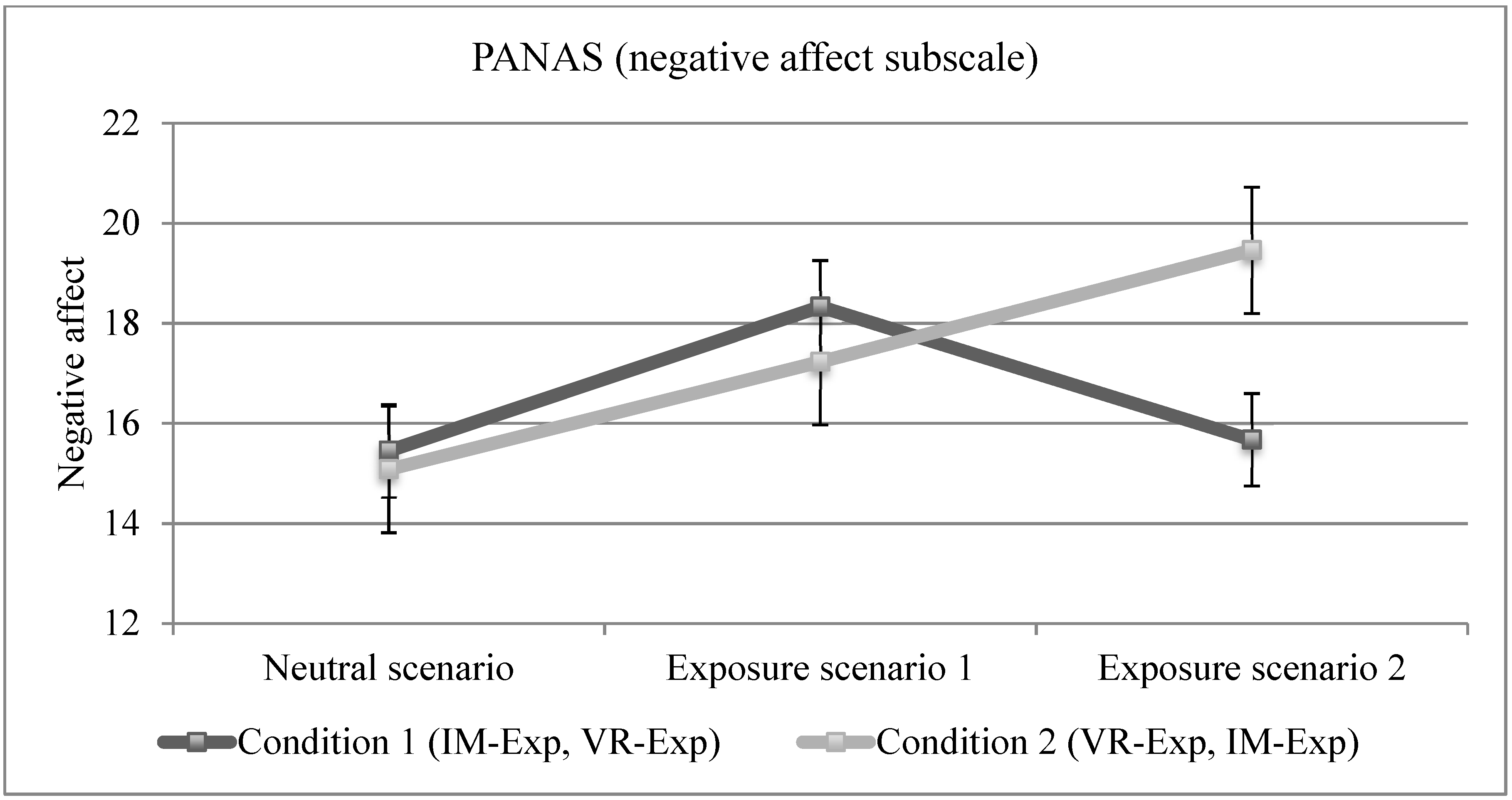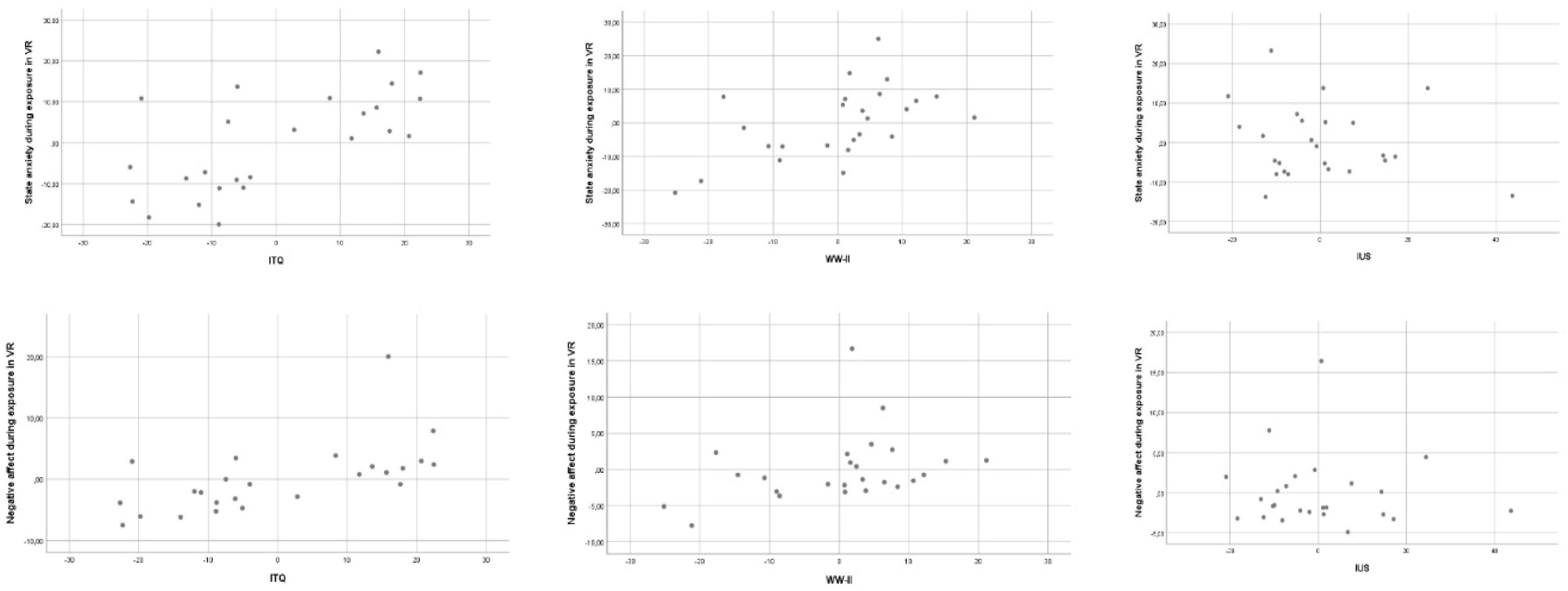Exposure to a Standardized Catastrophic Scenario in Virtual Reality or a Personalized Scenario in Imagination for Generalized Anxiety Disorder
Abstract
1. Introduction
2. Materials and Methods
2.1. Participants
2.2. Procedure
2.3. Virtual Environments (VE)
2.3.1. VE 1: Emergency Room
2.3.2. VE 2: Apartment
2.3.3. VE 3: Student Room
2.4. Measures
2.4.1. Diagnostic and Clinical Measures of Severity
Diagnostic Measure: Anxiety Disorders Interview Schedule for DSM-IV (ADIS-IV)
Clinical Measure: Penn State Worry Questionnaire (PSWQ)
Clinical Measure: Cognitive Avoidance Questionnaire (CAQ; Original French Version)
2.4.2. Measures of Users’ Experience in Virtual Reality
Users’ Experience: Presence Questionnaire (PQ)
Users’ Experience: Gatineau Presence Questionnaire (GPQ)
Users’ Experience: Simulator Sickness Questionnaire (SSQ)
2.4.3. Dependent Variables
Dependent Variable: State Scale of the State Trait Anxiety Inventory—Form Y1 (STAI-Y1)
Dependent Variable: Negative Affect Scale of the Positive and Negative Affect Schedule (PANAS)
2.4.4. Predictors of Levels of Anxiety and Negative Affect During the Immersion in VR
Predictor: Intolerance of Uncertainty Scale (IUS; Original French Version)
Predictor: Why Worry-II (WW-II)
Predictor: Immersive Tendencies Questionnaire (ITQ)
2.5. Experimenters and Hardware
3. Results
3.1. Sample Description
3.2. Statistical Analyses
4. Discussion
5. Conclusions
Author Contributions
Funding
Conflicts of Interest
References
- Marshall, W.L. Exposure. In Dictionary of Behavior Therapy Techniques; Bellack, A.S., Herson, M., Eds.; Pergamon Press: New York, NY, USA, 1986; pp. 121–124. [Google Scholar]
- Craske, M.G.; Treanor, M.; Conway, C.C.; Zbozinek, T.; Vervliet, B. Maximizing exposure therapy: An inhibitory learning approach. Behav. Res. Ther. 2014, 58, 10–23. [Google Scholar] [CrossRef] [PubMed]
- Richard, D.C.S.; Lauterbach, D.; Gloster, A.T. Description, mechanisms of action, and assessment. In Handbook of Exposure Therapies; Richard, D.C.S., Lauterbach, D., Eds.; Academic Press: Cambridge, MA, USA, 2007; pp. 1–28. [Google Scholar]
- Bouchard, S.; Robillard, G.; Larouche, S.; Loranger, C. Description of a treatment manual for in virtuo exposure with specific phobia. In Virtual Reality in Psychological, Medical and Pedagogical Applications; Eichenberg, C., Ed.; InTech: Rijeka, Croatia, 2012; pp. 82–108. [Google Scholar]
- Robillard, G.; Bouchard, S.; Fournier, T.; Renaud, P. Anxiety and presence during VR immersion: A comparative study of the reactions of phobic and non-phobic participants in therapeutic virtual environments derived from computer games. Cyberpsychol. Behav. 2003, 6, 467–476. [Google Scholar] [CrossRef] [PubMed]
- Laforest, M.; Bouchard, S.; Crétu, A.-M.; Mesly, O. Inducing an anxiety response using a contaminated virtual environment: Validation of a therapeutic tool for obsessive-compulsive disorder. Front. ICT 2016, 3, 18. [Google Scholar] [CrossRef]
- Kim, K.; Roh, D.; Kim, C.H.; Cha, K.R.; Rosenthal, M.Z.; Kim, S.I. Comparison of checking behavior in adults with or without checking symptoms of obsessive-compulsive disorder using a novel computer-based measure. Comput. Methods Programs Biomed. 2012, 108, 434–441. [Google Scholar] [CrossRef] [PubMed]
- McCann, R.A.; Armstrong, C.M.; Skopp, N.A.; Edwards-Stewart, A.; Smolenski, D.J.; June, J.D.; Metzger-Abamukong, M.; Reger, G.M. Virtual reality exposure therapy for the treatment of anxiety disorders: An evaluation of research quality. J. Anxiety Disord. 2014, 28, 625–631. [Google Scholar] [CrossRef] [PubMed]
- Chesham, R.K.; Malouff, J.M.; Schutte, N.S. Meta-analysis of the efficacy of virtual reality exposure therapy for social anxiety. Behav. Chang. 2018, 35, 1–15. [Google Scholar] [CrossRef]
- Fernández-Alvarez, J.; Rozental, A.; Carlbring, P.; Colombo, D.; Riva, G.; Anderson, P.L.; Baños, R.M.; Benbow, A.A.; Bouchard, S.; Bretón López, J.M.; et al. Deterioration rates in virtual reality exposure therapy: An individual patient data level meta-analysis. J. Anxiety Disord. 2018, in press. [Google Scholar] [CrossRef]
- Morina, N.; Ijntema, H.; Meyerbroker, K.; Emmelkamp, P.M.G. Can virtual reality exposure therapy gains be generalized to real-life? A meta-analysis of studies applying behavioral assessments. Behav. Res. Ther. 2015, 74, 18–24. [Google Scholar] [CrossRef] [PubMed]
- Tisseau, J. In vivo, in vitro, in silico, in virtuo. In Proceedings of the 1st Workshop on SMA in Biology at Meso or Macroscopic Scales, Paris, France, 2 July 2008; pp. 1–17. [Google Scholar]
- Fuchs, P.; Moreau, G.; Guitton, P. Virtual Reality: Concepts and Technologies; CRC Press: New York, NY, USA, 2011. [Google Scholar]
- Wiederhold, B. Virtual Reality in the 1990s: What Did We Learn? Cyberpsychol. Behav. 2004, 3, 311–314. [Google Scholar] [CrossRef]
- Blade, R.A.; Padgett, M.L. Virtual Environments Standards and Terminology. In Handbook of Virtual Environments: Design, Implementation, and Applications; Stanney, K., Ed.; Lawrence Erlbaum Associates Publishers: Mahwah, NJ, USA, 2002; pp. 21–33. [Google Scholar]
- Hirai, M.; Vernon, L.L.; Cochran, H. Exposure for phobias. In Handbook of Exposure Therapies; Richard, D.C.S., Lauterbach, D., Eds.; Academic Press: San Diego, CA, USA, 2007; pp. 247–270. [Google Scholar]
- Garcia-Palacios, A.; Hoffman, H.G.; Kwon See, S.; Tsai, A.; Botella, C. Redefining therapeutic success with VR exposure therapy. Cyberpsychol. Behav. 2001, 4, 341–348. [Google Scholar] [CrossRef] [PubMed]
- Dugas, M.J.; Gagnon, F.; Ladouceur, R.; Freeston, M.H. Generalized anxiety disorder: A preliminary test of a conceptual model. Behav. Res. Ther. 1998, 36, 215–226. [Google Scholar] [CrossRef]
- Dugas, M.; Ladouceur, R. Treatment of GAD. Targeting intolerance of uncertainty in two types of worry. Bheav. Modif. 2000, 24, 635–657. [Google Scholar] [CrossRef] [PubMed]
- Freeston, M.H.; Rhéaume, J.; Letarte, H.; Dugas, M.J.; Ladouceur, R. Why do people worry? Personal. Individ. Differ. 1994, 17, 791–802. [Google Scholar] [CrossRef]
- Dugas, M.J.; Robichaud, M. Cognitive-Behavioral Treatment for Generalized Anxiety Disorder; Routledge: New York, NY, USA, 2007. [Google Scholar]
- Goldman, N.; Dugas, M.J.; Sexton, K.A.; Gervais, N.J. The impact of written exposure on worry. Behav. Modif. 2007, 31, 512–538. [Google Scholar] [CrossRef] [PubMed]
- Bouchard, S.; Côté, S.; Richard, D.C.S. Virtual reality applications for exposure. In Handbook of Exposure Therapies; Richard, D.C.S., Lauterbach, D., Eds.; Academic Press: Cambridge, MA, USA, 2007; pp. 347–388. [Google Scholar]
- Dallaire, L.; Bouchard, S. Identification des thèmes récurrents d’exposition dans le cadre du traitement cognitif du TAG. Unpublished Manuscript. 2007. [Google Scholar]
- Guitard, T.; Bouchard, S.; Bélanger, C. Exposure to standardized catastrophic scenarios with patients suffering from GAD. Presented at the 45th Annual Convention of the Association for Behavioral and Cognitive Therapy (ABCT), Toronto, ON, Canada, 10–13 November 2011. [Google Scholar]
- Brown, T.A.; DiNardo, P.A.; Barlow, D.H. Anxiety Disorders Interview Schedule for DSM-IV (ADIS-IV); Psychological Corporation: San Antonio, TX, USA, 1994. [Google Scholar]
- Meyer, T.J.; Miller, M.L.; Metzger, R.L.; Borkovec, T.D. Development and validation of the Penn State Worry Questionnaire. Behav. Res. Ther. 1990, 28, 487–495. [Google Scholar] [CrossRef]
- Ladouceur, R.; Freeston, M.H.; Dumont, J.; Letarte, H.; Rhéaume, J.; Gagnon, F.; Thibodeau, N. Penn State Worry Questionnaire: Validity and reliability of a French translation. Can. Psychol. 1992, 33, 236. [Google Scholar]
- Molina, S.; Borkovec, T.D. The Penn State Worry Questionnaire: Psychometric properties and associated characteristics. In Worrying: Perspectives on Theory, Assessment and Treatment; Davey, G.C.L., Tallis, F., Eds.; John Wiley & Sons: New York, NY, USA, 1994; pp. 265–283. [Google Scholar]
- Gosselin, P.; Langlois, F.; Freeston, M.H.; Ladouceur, R.; Dugas, M.J.; Pelletier, O. Le questionnaire d’évitement cognitif: Développement et validation auprès d’adultes et d’adolescents. Journal de thérapie comportementale et cognitive 2002, 12, 24–37. [Google Scholar]
- Gosselin, P.; Dugas, M.J.; Ladouceur, R.; Freeston, M.H. Évaluation des inquiétudes: Validation d’une traduction française du Penn State Worry Questionnaire. L’Encéphale 2001, 27, 475–484. [Google Scholar] [PubMed]
- Robillard, G.; Bouchard, S.; Renaud, P.; Cournoyer, L.G. Validation canadienne-française de deux mesures importantes en réalité virtuelle: l’Immersive Tendencies Questionnaire et le Presence Questionnaire. In Proceedings of the 25ième congrès de la Société Québécoise pour la Recherche en Psychologie (SQRP), Trois-Rivières, QC, Canada, 1–3 November 2002. [Google Scholar]
- Witmer, B.G.; Singer, M.J. Measuring presence in virtual environments: A presence questionnaire. Presence 1998, 7, 225–240. [Google Scholar] [CrossRef]
- Bouchard, S.; Robillard, G.; Renaud, P. Revising the factor structure of the Simulator Sickness Questionnaire. Annu. Rev. Cyberther. Telemed. 2007, 5, 117–122. [Google Scholar]
- Kennedy, R.S.; Lane, N.E.; Berbaum, K.S.; Lilienthal, M.G. Simulator sickness questionnaire: An enhanced method for quantifying simulator sickness. Int. J. Aviat. Psychol. 1993, 3, 203–220. [Google Scholar] [CrossRef]
- Gauthier, J.; Bouchard, S. Adaptation canadienne-française de la forme révisée du State-Trait Anxiety Inventory de Spielberger. Revue Canadienne des Sciences du Comportement 1993, 25, 559–578. [Google Scholar] [CrossRef]
- Spielberger, C.D.; Gorsuch, R.L.; Lushene, R.; Vagg, P.R.; Jacobs, G.A. Manual for the State-Trait Anxiety Inventory; Consulting Psychologists Press: Palo Alto, CA, USA, 1983. [Google Scholar]
- Gaudreau, P.; Sanchez, X.; Blondin, J.P. Positive and negative affective states in a performance-related setting: Testing the factorial structure of the PANAS across two samples of French-Canadian participants. Eur. J. Psychol. Assess. 2006, 22, 240–249. [Google Scholar] [CrossRef]
- Watson, D.; Clark, L.; Tellegen, A. Development and validation of brief measures of positive and negative affect: The PANAS scales. J. Personal. Soc. Psychol. 1988, 54, 1063–1070. [Google Scholar] [CrossRef]
- Bouvard, M. Questionnaires et échelles d’évaluation de la personnalité, 3rd ed.; Elsevier Masson: Paris, France, 2009. [Google Scholar]
- Cohen, J. Statistical Power Analysis for the Behavioral Sciences; Lawrence Erlbaum Associates: London, UK, 1988. [Google Scholar]
- Labbé Thibault, P.; Côté, G.; Gosselin, P. Effet de l’exposition en réalité virtuelle sur les symptômes du trouble d’anxiété généralisée. Ph.D. Thesis, Université de Sherbrooke, Sherbrooke, QC, Canada, 2017. [Google Scholar]
- Repetto, C.; Gaggioli, A.; Pallavicini, F.; Cipresso, P.; Raspelli, S.; Riva, G. Virtual reality and mobile phones in the treatment of generalized anxiety disorders: A phase-2 clinical trial. Pers. Ubiquitous Comput. 2013, 17, 253–260. [Google Scholar] [CrossRef]
- Katzman, M.; Bleau, P.; Blier, P.; Chokka, P.; Kjernisted, K.; Van Ameringen, M.; Antony, M.; Bouchard, S.; Brunet, A.; Flament, M.; et al. Canadian clinical practice guidelines for the management of anxiety, posttraumatic stress and obsessive-compulsive disorders. BMC Psychiatry 2014, 14 (Suppl. 1), S1. [Google Scholar] [CrossRef] [PubMed]
- Diemer, J.; Mühlberger, A.; Pauli, P.; Zwanzger, P. Virtual reality exposure in anxiety disorders: Impact on psychophysiological reactivity. World J. Biol. Psychiatry 2014, 15, 427–442. [Google Scholar] [CrossRef] [PubMed]



| Variable | N | % | Mean (SD) |
|---|---|---|---|
| Nationality | |||
| Canadian | 25 | 89.3 | |
| Senegalese | 1 | 3.6 | |
| Level of education | |||
| University (some or completed) | 18 | 64.3 | |
| College or professional diploma | 5 | 17.9 | |
| High school diploma | 3 | 10.7 | |
| Some high school | 2 | 7.1 | |
| Socioeconomic status | |||
| High | 9 | 32.1 | |
| Middle | 15 | 53.6 | |
| Low | 4 | 14.3 | |
| Marital status | |||
| Married | 10 | 35.7 | |
| Single | 8 | 28.6 | |
| Common-law partner | 8 | 28.6 | |
| Divorced | 2 | 7.1 | |
| Descriptive clinical measures of generalized anxiety disorder | |||
| Anxiety Disorders Interview Schedule-IV severity of GAD | 5.7 (0.93) | ||
| Penn State Worry Questionnaire | 59.88 (8.89) | ||
| Cognitive Avoidance Questionnaire | 68.32 (20.35) | ||
| Descriptive measures of users’ experience in virtual reality | |||
| Presence Questionnaire after the VR-Exp scenario | 61.17 (19.05) | ||
| Gatineau Presence Questionnaire after the VR-Exp scenario | 89.90 (14.32) | ||
| Simulator Sickness Questionnaire after the VR-Exp scenario | 9.57 (6.65) | ||
| Predictive measures selected for exploratory analyses | |||
| Intolerance of Uncertainty Scale | 68.61 (21.62) | ||
| Why Worry-II Questionnaire | 47.29 (17.93) | ||
| Immersive Tendencies Questionnaire | 70.88 (16.81) | ||
| Measure and Scenario | Condition | |||
|---|---|---|---|---|
| IM-Exp/VR-Exp | VR-Exp/IM-Exp | |||
| M | (SD) | M | (SD) | |
| STAI-Y1 | ||||
| Neutral environment | 39.67 | (10.83) | 41.92 | (13.12) |
| Exposure scenario 1 | 50.20 | (12.81) | 46.00 | (12.91) |
| Exposure scenario 2 | 47.00 | (12.66) | 51.00 | (14.74) |
| PANAS_NA | ||||
| Neutral environment | 15.47 | (5.14) | 15.08 | (4.25) |
| Exposure scenario 1 | 18.33 | (6.23) | 17.23 | (5.12) |
| Exposure scenario 2 | 15.67 | (3.60) | 19.46 | (8.61) |
| Effect | MS | df | F | p | ηp2 |
|---|---|---|---|---|---|
| STAI-Y1 | |||||
| Time | 564.10 | 2 | 9.03 | < 0.001 | 0.258 |
| Time × Condition | 129.96 | 2 | 2.08 | 0.135 | 0.074 |
| Condition | 4.06 | 1 | 0.01 | 0.92 | 0.000 |
| PANAS_NA | |||||
| Time | 53.87 | 2 | 2.97 | 0.60 | 0.102 |
| Time × Condition | 48.75 | 2 | 2.69 | 0.078 | 0.094 |
| Condition | 56.38 | 1 | 0.61 | 0.44 | 0.023 |
© 2019 by the authors. Licensee MDPI, Basel, Switzerland. This article is an open access article distributed under the terms and conditions of the Creative Commons Attribution (CC BY) license (http://creativecommons.org/licenses/by/4.0/).
Share and Cite
Guitard, T.; Bouchard, S.; Bélanger, C.; Berthiaume, M. Exposure to a Standardized Catastrophic Scenario in Virtual Reality or a Personalized Scenario in Imagination for Generalized Anxiety Disorder. J. Clin. Med. 2019, 8, 309. https://doi.org/10.3390/jcm8030309
Guitard T, Bouchard S, Bélanger C, Berthiaume M. Exposure to a Standardized Catastrophic Scenario in Virtual Reality or a Personalized Scenario in Imagination for Generalized Anxiety Disorder. Journal of Clinical Medicine. 2019; 8(3):309. https://doi.org/10.3390/jcm8030309
Chicago/Turabian StyleGuitard, Tanya, Stéphane Bouchard, Claude Bélanger, and Maxine Berthiaume. 2019. "Exposure to a Standardized Catastrophic Scenario in Virtual Reality or a Personalized Scenario in Imagination for Generalized Anxiety Disorder" Journal of Clinical Medicine 8, no. 3: 309. https://doi.org/10.3390/jcm8030309
APA StyleGuitard, T., Bouchard, S., Bélanger, C., & Berthiaume, M. (2019). Exposure to a Standardized Catastrophic Scenario in Virtual Reality or a Personalized Scenario in Imagination for Generalized Anxiety Disorder. Journal of Clinical Medicine, 8(3), 309. https://doi.org/10.3390/jcm8030309






